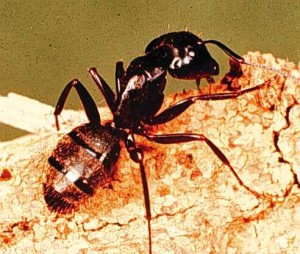SAN ANTONIO EXPRESS-NEWS
GARDENING, ETC
Sunday, June 29, 2003
By Nathan Riggs
There are over 320 different species of ants in Texas; in Bexar County there are at least 50 different types. Most of these are harmless and do not come in contact with man, his buildings, property, or plants. One of these ants that occasionally enters homes is the Carpenter, or Wood ant. After the recent rains, many homeowners have noticed Carpenter Ants in their homes and called the Bexar County Extension office with questions and concerns about them. This week’s article from the Bexar County Extension office will present information on these ants.
Carpenter ants (Camponotus ssp.) build their nests in hollow trees or other cavities, including the walls of buildings. They usually take advantage of wood that is damaged by water and nest in it. These ants will excavate (not eat) water damaged wood, ejecting the dark particles of wood from the nest in piles. In homes or buildings, these piles resemble sawdust or coffee grounds, and are commonly seen near doors or windows in proximity to their nest. They will also tear up and eject fiberglass insulation and drywall.
Carpenter ants prefer to nest in trees as their first choice. Favorite trees include oaks, hackberry and ash, because they hollow very easily and provide easy nest sites.
Generally carpenter ants have a central nest and one or two “satellite” nests in other locations. They feed on insects and sweet liquids they find in the environment. Sometimes they will be attracted to sweet crumbs and other sources of sugar indoors as well as water in kitchens, bathrooms and laundry rooms.
How do they get indoors? The most common avenue that leads carpenter ants to homes is tree branches that are allowed to touch the home. They also may use power lines as a means to find the structure. In homes, carpenter ants usually nest in water damaged wood around windows, doors, kitchens and bathrooms. They are not nearly as destructive as termites because they do not eat wood like termites do.
What do we do about carpenter ants? If they are found in a hollow tree, they are doing what comes naturally and not, repeat NOT, harming the tree. If found in a building, the nest must be killed to truly mitigate the problem and prevent long-term damage.
To find the nest in a structure, look for piles of sawdust, insulation, gypsum or dead bug parts near doors or windows. Somewhere above the piles, there will be a hole or crack through which the ants are ejecting this material. The nest will be fairly close to this hole or crack. Often, an aerosol spray burst of two or three seconds in length into the hole or crack will do the trick. Carpenter ant nests are difficult to control, so don’t expect perfect results each time. There is also a bait called Advance that is used for carpenter ants as well. It is not sold on the retail level, but is available at local chemical dealers such as Estes, Lesco or Van Waters and Rogers, to name a few. A pesticide license is not required to purchase this material.
One last note: carpenter ants are large in size–up to one-half inch long, and they are either red with a black tail or all honey-colored. Remember, they do not harm trees and they do not eat wood like termites do. They still can damage a structure over time, so be sure to trim all branches away from your home to reduce the chances of these unwanted six-legged engineers. Try to prevent water damage around windows and doors by caulking and applying weather stripping where applicable.
This article was provided by Nathan Riggs, Extension Agent – Integrated Pest Management-Bexar County.
